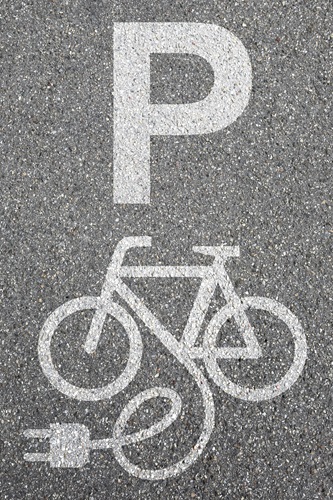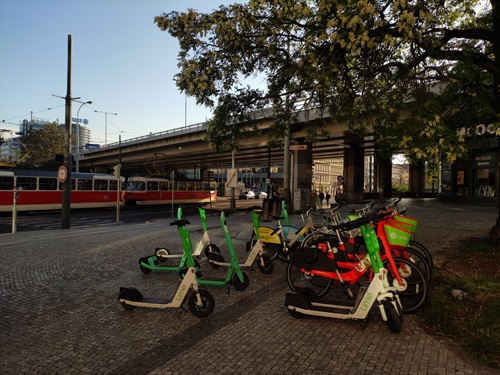
It’s a sign of the times: Mackinac Island, Michigan (that famously car-free town that was the setting of the kitschy 1979 cult classic, “Somewhere in Time” with Christopher Reeve and Jane Seymour), has passed a law creating a speed limit for electric bicycles (also known as ebikes).
Meanwhile, in New York, Governor Kathy Hochul signed a legislative package to encourage the safe use of e-bikes. Many of the new laws pertain to regulation of lithium-ion batteries, typically found in e-bikes; these batteries are seen as a hazard because they contain material that is highly flammable.
The risks and hazards associated with lithium ion batteries include fire and explosion, radiation, heat, as well as chemical and electrical burns. (Those who fly regularly are accustomed to being asked by TSA if their luggage contains such batteries.)
The legislation in New York also addresses user behavior, requiring retailers to affix a notice to any bicycles with electric assist and micro-mobility devices, stating that the rider must always yield to pedestrians and follow traffic laws.
And retailers in New York better get ready: The legislation packs a punch, noting that any retail entity who violates the ebike notification law may be penalized with a fine of no more than $250 per unit for the first offense and no more than $1,000 for each subsequent offense.
This comes in the wake of nationwide complaints from drivers and pedestrians that ebike users often ride on sidewalks, go against the flow of traffic and park vehicles illegally. It’s a problem with dockless electrical scooters as well; although users are supposed to park their vehicles properly when they are done using them, some simply leave them on sidewalks, in streets and even inside buildings. In many cases, cities, like Charlottesville, are hitting the companies that manage rental ebikes and scooters with fines for illegal parking.
It's not uncommon for rental scooters and ebikes to be stolen and destroyed by vigilantes who are tired of seeing them left around; in Oakland, California, one such individual, known as “The Lime Guy,” began swiping dozens of scooters and tossing them into local lakes. Ecologists were not amused.
 In San Francisco, Scoot Network told the Wall Street Journal that 250 of the 650 scooters had been stolen or irreparably damaged within a week of their launch in the city:
In San Francisco, Scoot Network told the Wall Street Journal that 250 of the 650 scooters had been stolen or irreparably damaged within a week of their launch in the city:
“To those who hate them, they’re like an invasion from a dystopian robot future. To their fans, they’re the future of urban transport: green, high tech and fun. What is undeniable is that the rollout could hardly be described as smooth, with vigilantes, decrying what they describe as typical tech industry hubris of companies profiting off of public spaces, expressing their displeasure through vandalism. Some have defaced the vehicles with profane stickers and feces. Others have tossed them into trash cans and trees.”
Event owners of road races have had to contend with scooters and ebikes left on courses illegally, where they pose a hazard to runners. In one case, a legally blind runner in Texas tripped over a scooter and was badly injured.
In California, Hermosa Beach has banned ebike riders from speeding, racing or stunt activities. Those under the age of 18 are required to wear a helmet and tandem riding is only permitted on units that provide enough seats. It also prohibits the use of E-bikes on Pier Plaza, a walkable area containing several shops and restaurants, and the Greenbelt, a landscaped trail that runs between Ardmore and Valley Drive in Hermosa Beach.
Ebikes have also found acceptance in the competitive arena. Nationwide, the form of riding that was once seen as “mechanical doping” now has its own registration categories in racing. The European Cycling Union, in 2019, announced racing circuit for ebikes. The Sea Otter Classic was ahead of the game, announcing an inaugural ebike registration category in 2016. (Interesting note: The ebike category was not sanctioned by USA Cycling at the time; it would not be until 2020 that the NGB welcomed ebikes to the fold.)
Overall, ebikes are viewed by NGBs, as well as event owners, as well as cities, as a way of getting more people outside and onto bicycles. However, that doesn’t mean they’re welcome everywhere. Some cities have outlawed them, while others have enacted stricter regulations.
Whether users have the ability to ride ebikes in parks (local, state or federal) is a guessing game at best, said an article in Cycling Weekly:
“It is a patchwork across the nation, depending on the state, the federal agency,” says People for Bikes eMTB policy and program manager Rachel Fussell. “Even within the federal agencies – the U.S. Forest Service defines e-bikes specifically as motorized [vehicles], whereas the U.S. Department of Interior [which oversees national parks], classifies them as electric bicycles. To further complicate guidelines: There’s no single catch-all rule for using e-bikes on state-managed parklands.”
The National Parks System uses an e-bike classification adopted by the Bureau of Land Management, which recognizes three categories of ebikes; as of August 1, 2023 all three classes of e-bike may be used on national park lands wherever non-motorized bicycles are allowed. However, the National Park Service indicates park superintendents may choose to permit some, but not all, classes of e-bikes to use park lands. A specific park, for example, may allow class I and II e-bikes but prohibit class III e-bikes.
 Confusing laws aside, one thing is for sure: The use of ebikes is only going to continue to grow. Many states, such as Massachusetts, are offering rebates and other incentives to those who purchase ebikes, in fact. Count on NGBs and others to continue to welcome riders to events in the interest of broadening the scope of the sport.
Confusing laws aside, one thing is for sure: The use of ebikes is only going to continue to grow. Many states, such as Massachusetts, are offering rebates and other incentives to those who purchase ebikes, in fact. Count on NGBs and others to continue to welcome riders to events in the interest of broadening the scope of the sport.
At the same time, we haven’t seen the last of the regulations meant to try to keep ebike users on the straight and narrow (including off the sidewalk).

